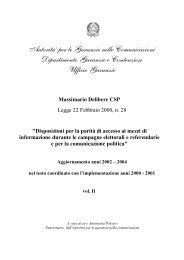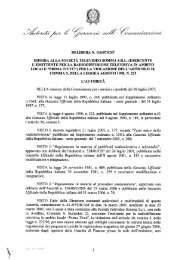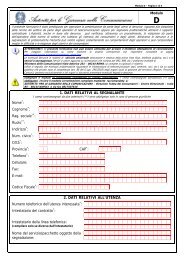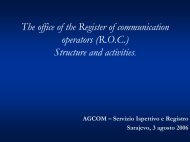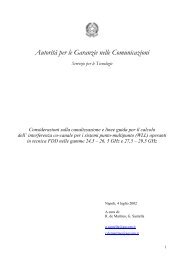Communications Regulatory Authority
Communications Regulatory Authority
Communications Regulatory Authority
You also want an ePaper? Increase the reach of your titles
YUMPU automatically turns print PDFs into web optimized ePapers that Google loves.
the topics of universal service, network security, and the appeal procedures before<br />
national jurisdictional bodies. All the national delegations shared the concern over the<br />
network security situation, and they pointed out the advisability of defining precise<br />
obligations for network and service providers. In consideration of the future entry into<br />
effect of the reformed regulations, the discussion is still ongoing over the possible<br />
expansion of the universal service contents to the broadband services and mobile<br />
services.<br />
Lastly, with regard to the possibility of harmonizing the appeal procedures<br />
before national jurisdictional bodies, in order to avoid the risk of adoptions of national<br />
decisions that conflict with the Community regulatory framework, the Commission<br />
pointed out the particular delicacy of the subject, in consideration of the strong<br />
peculiarities and regulatory differences that characterize the legal systems of the single<br />
Member States.<br />
The first results of the discussion registered, also within the COCOM, an<br />
agreement of principle of the Member States on the advisability of streamlining the<br />
market notification procedures under Article 7 of the framework directive and of<br />
improving the conditions for managing the spectrum.<br />
AGCOM’s institutional participation, coordinated with the Ministry of<br />
<strong>Communications</strong>, continued in the national delegation with the Radio Spectrum<br />
Committee, set up by European Parliament and Council decision no. 676/2002/EC of 7<br />
March 2002 (the so-called “radio spectrum” decision). It should be remembered that the<br />
Committee was set up for the electronic communication networks and services, in the<br />
context of the European regulatory framework of 2002, with the objective of assisting<br />
the Commission in the definition and adoption of the technical implementation<br />
measures suitable for fostering a higher degree of harmonization in the spectrum<br />
policies. The aim is to render this scarce resource available in a coordinated manner and<br />
efficiently useable at the European level and, as a result, to contribute to the<br />
development of the European internal market.<br />
During the period of reference, the Committee continued to deal with the themes<br />
concerning the harmonization of the spectrum for short range devices (SRD), the<br />
Terrestrial Flight Telephone System (TFTS), the additional 2.6 GHZ band for mobile<br />
systems, the use of radio frequency identification devices (RFID), and 2GHz mobile<br />
satellite systems (MSS), with the adoption of the related CEPT reports and, in some<br />
cases, the preparation of a decision draft. Also noteworthy are the adoption of<br />
Community decisions concerning the harmonization of the use of the 5 GHz spectrum<br />
for Radio-LAN and for the future use of the former ERMES band, the adoption of<br />
mandates to the CEPT regarding the specifications for a Community information on<br />
spectrum use and the compatibility studies for broadband wireless access (BWA), as<br />
well as an initial consultation on the harmonized introduction of the Wireless Access<br />
Policy for Electronic Communication Systems (WAPECS) platforms.<br />
220




